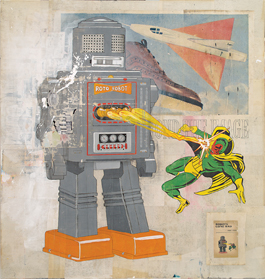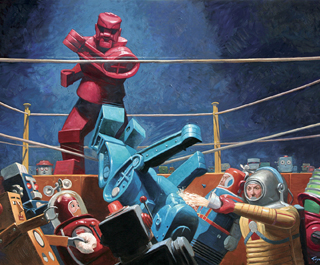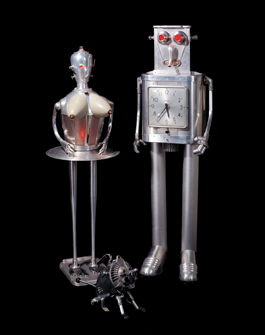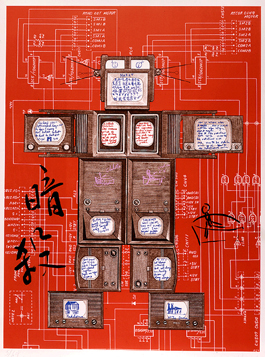home | metro silicon valley index | the arts | visual arts | review

Photograph by Felipe Buitrago
EASY, BIG FELLA: Michael A. Salter's 'Styrobot' stands guard over the robot show at the San Jose Museum of Art.
Our Robots, Ourselves
Artists wrestle with the meaning of mechanical life in robots show at San Jose Museum of Art
By Michael S. Gant
THE CYLONS were created by man. They rebelled. They evolved." Isn't that always the way with robots? We built a helpmate to avoid the ethical problem of slavery, and then the damn things get smart and throw off their electronic shackles. The Cylons—the female models, anyway—even turned out to be stronger, smarter and definitely better-looking than their human overseers on Battlestar Galactica. The ultimate existential crisis for mankind is that robots will out-evolve us.
On the other hand, in Woody Allen's future satire Sleeper, the robots work as herky-jerky butlers in tuxes, easily imitated by the hapless Allen with some white-face, tin hat and pour spout stuck in his mouth. In popular culture, we lurch between a desire for a domesticated robot to cook, clean and be companionable (servants for all, without class warfare; pets without poop) and angst about laser-beam-toting "toasters" reducing us to the status of inferiors.
Our love-fear affair with robots—and more particularly with the idea of robots—is explored in an entertaining new show at the San Jose Museum of Art called "Robots: Evolution of a Cultural Icon" and assembled by senior curator JoAnne Northrup. The artists represented comment on, appropriate, exult in and refigure robot images and tropes as a way of coping with that horrifying, exhilarating moment when Dr. Frankenstein turned on the juice and started screaming, "It's alive! It's alive! It's alive!"

Courtesy of the artist
BLAST PICTURE SHOW: The Robots seem to be winning in a detail from Michael Mew's 'Robot 4.'
Those words, as belted out by Colin Clive in James Whale's classic film, can be heard in Amy Hicks' DVD projection ReAdaptations: The Book Series. Hicks, a lecturer at Stanford, takes canonical creation texts—Frankenstein, The Stepford Wives, Asimov's I, Robot—and covers their pages with pasted-on stills from the film adaptations. With stop-motion animation in the old-fashioned "flip-book" style, she brings the stories to an uneasy half-life somewhere between the authors' original concept and the filmmakers' creative distortions. As always, the stories we tell take on lives of their own, not unlike robots.
Several artists make like Dr. Frankenstein. Korean artist Nam June Paik started converting old TV sets into chunky robots decades ago. Cyberkid is fashioned from a series of small video monitors with a larger module sprouting Medusa-like cables for the "head." The screens broadcast a synchronized loop of swirling, hypnotic images.

Collection of Mark Holt, photograph courtesy of the artist and the Shooting Gallery, San Francisco
WHAT WE OUGHT NOT, WE DO: An oil on wood panel painting from 2006 by Eric Joyner
Clayton Bailey and Nemo Gould tinker together funky, almost cartoonish robots from cast-off parts: metal housings from vacuum cleaners, crimped conduit, hinged scoops. Bailey's fetching Beautybot has capacious conical breasts, a warm glowing light in her belly and an inverted coffee urn for a head; her companion, Boybot, sports a large analog clock for a chest—he'll never be late for a date. Bailey also makes glazed porcelain robots, reducing the possibly menacing figure to the status of kitchen tchotchke.
Gould's looming found-part beings are both works of arts and, after a fashion, actual robots. With a motion sensor, General Debris rotates his shoulders menacingly when visitors cross his field of vision. Little Big Man has long metal arms and legs attached to an old wooden radio cabinet for a torso. Inside, a second, smaller robot pulls levers that make the big one move. Even robots have robot bosses.

From the SJMA Permanent Collection, photography by Douglas Sandberg
FAMILY GATHERING: 'Beautybot' (2000), 'Boybot' (2000) and 'Robot Pet' (1990) by Clayton Bailey
Interestingly, concern over global warming may be supplanting nightmares about robot revolts, so creative recycling of consumer detritus is a strong theme in the show. The biggest recycler of them all is Michael A. Salter, who built the Styrobot that dominates the central, vaulted gallery. The monster/guardian is jigsawed-puzzled together from pieces of Styrofoam packing cases—the hard-shell kind often used to ship computers. The nearly infinite patterns of holes and curves and ridges in the Styrofoam give the creature an aura of pure practicality—no fancy streamlining required. The Styrobot is surrounded by two dozen small sentinels, each a clever transformation of simple shapes into a pugnacious simulacrum of life.
Thomas Zummer's subtly shaded graphite drawings are aesthetic renditions of historical robot experiments. Some of the optimistic projects from the '50s feature compliant household 'bots who iron, dust and vacuum—indeed, the main dream Zummer captures is the wish that someone, something else, would take up the burden of housework. Some of these robots even have teeth and take cigarette breaks.
Adults may stay awake worrying about robots, but kids go to sleep dreaming of them. Several artists are smitten by the toy robot, all bright colored tin and injection-molded plastic. San Jose photographer David Pace poses toy bots in rigorous grids, straight on, as if positing a taxonomy. Gail Wight, an associate professor at Stanford, carries the idea one step further. In three ink-jet prints called Anatomies, she photographs the dissected parts of tin robots, laying them out in symmetrical fashion against a shiny white backdrop, as if for a medical textbook.

Collection of Carl and Elizabeth Solway, image ęCarl Solway Gallery, Inc., Cincinnati
REVOLUTIONARY: 'Marat' is one of a series of lithographs by Nam June Paik combining robot images and echoes of the French revolution
Michael Mew, an Oakland artist who is a real find, layers pasted pictures of toy robots with various collage materials and applies a transparent resin coating to pull the elements together. In his Robots Gone Bad series, oversize toys spit flames at their opponents, which include a caped superhero, a jet plane and a giant wing-tip show floating in space. In Pulling the Plug, another robot holds a frayed electrical cord, surrounded by overlapping images of an astrolabe, a globe, Chinese characters and torn pages from a dictionary. Is it pulling the plug on itself or the world?
Jumping scales, Michael McMillen (whose wonderful peep-hole diorama, The Third Eye, is one of the museum's best permanent holdings) photographs a tiny broken-down robot model and then blows it up to gargantuan size on a vinyl banner. Down to its last diode, perhaps, the robot is poised against a fiery, apocalyptic nuclear sunset. In a true crossover moment, a display case shows off some of Clayton Bailey's actual toy robots. One look at Mr. Mercury with his big shiny red feet, and it's easy to understand the allure.
The toy 'bots also go at it hammer, tongs and pinchers in Eric Joyner's oil-on-wood-panel paintings. In What We Ought Not, We Do, a fierce red toy robot delivers a knockout punch to a blue robot, sending it sprawling over the ropes of a boxing ring into a crowd of agitated robot spectators. The picture wittily references George Bellows' painting Dempsey and Firpo. One can only hope it isn't a veiled allegory about the red state/blue state divide in electoral politics.
The last word belongs to Gail Wight. In a small, animated diorama called Star Struck, a toy robot sits in a frayed easy chair. Clutching a tissue, the robot rocks back and forth as if seized with sobs. He is watching a tiny TV set that is broadcasting Fritz Lang's seminal sci-fi film Metropolis and weeping over the fate of the movie's shimmering gold robot Maria. Of course, as far as he is concerned, the robot Maria is the heroine, not the villain, of the piece. After all, somebody has to keep those human workers in the Underground City in their place.
Robot Roll-Call: Metro's critics pick their favorite robots
The Robots
Are Coming: Click Here to watch Michael A. Salter and helpers erect the giant Styrobot at the San Jose Museum of Art
ROBOTS: EVOLUTION OF A CULTURAL ICON runs through Oct. 19 at the San Jose Museum of Art, 110 S. First St., San Jose; 408.271.6840. See more on robots at www.metroactive.com.
Send a letter to the editor about this story.
|
|
|
|
|
|